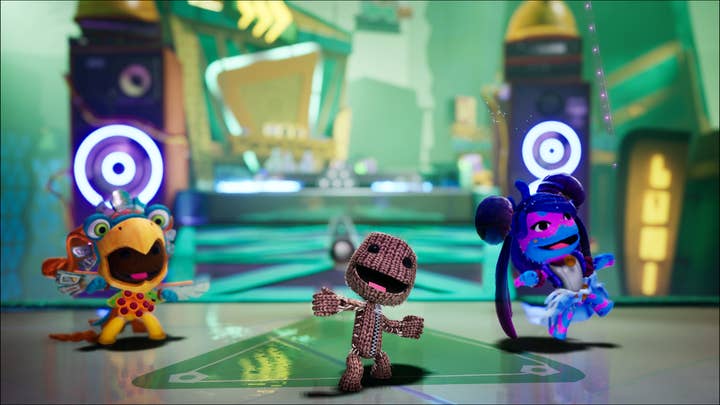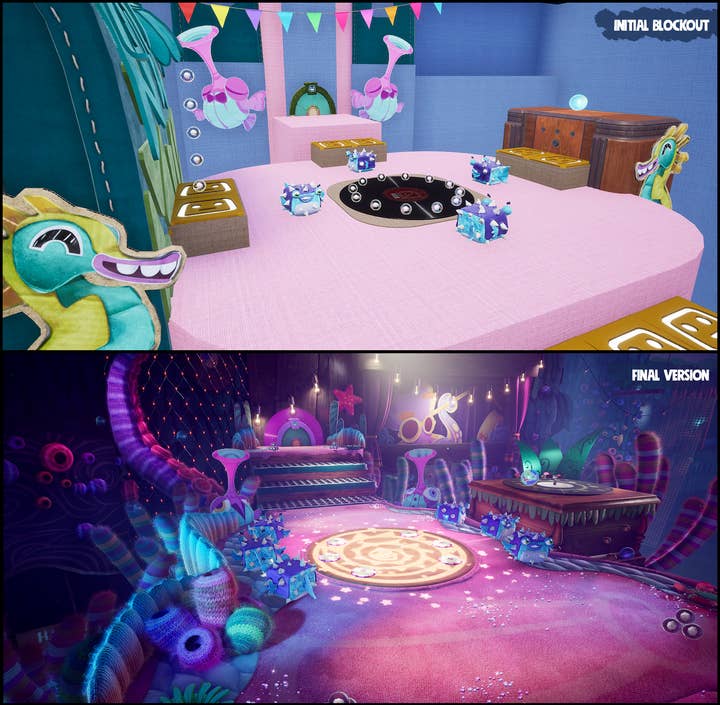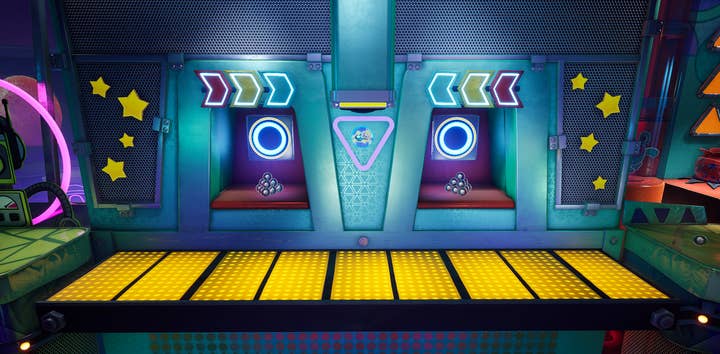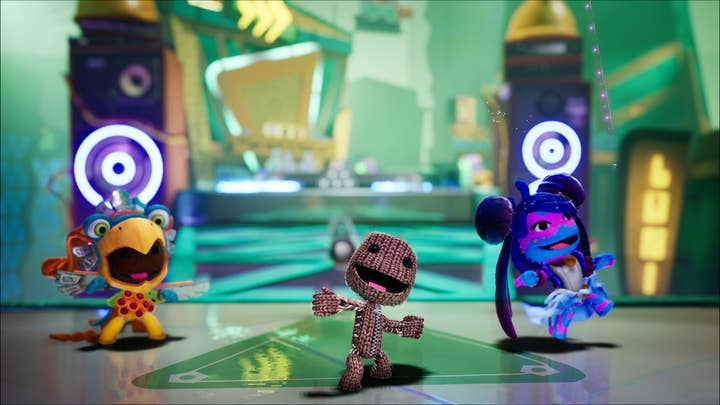Making platforming pop: How Sumo built Sackboy's music levels
For the GamesIndustry.biz Academy, Jack Houghton explains how Sumo matched licensed music and gameplay in Sackboy: A Big Adventure
Released as a launch title for the PlayStation 5, Sackboy: A Big Adventure is a 3D platformer for up to four players.
People loved the game for a variety of reasons, but the levels in the game choreographed entirely to iconic pop tracks connected particularly well with our audience.
This article will cover how we built these levels, picked the tracks and, crucially, how we pulled it all together.
The intro
Sackboy originally shot to fame in LittleBigPlanet of course -- a franchise renowned for its eclectic soundtrack. When we set out to make Sackboy: A Big Adventure, this legacy was something we were keen to honour and build on.
The game features an eclectic mix of licenced music, original interactive pieces, and even an array of left field covers, such as a ballet-inspired, waltz arrangement of Madonna's Material Girl.
"LittleBigPlanet [is] a franchise renowned for its eclectic soundtrack. This legacy was something we were keen to honour and build on"
It also showcases five 'music levels', where the environment and gameplay are synchronised to a certain iconic track. These levels feature songs such as the 70's funk hit Jungle Boogie by Kool and the Gang, the pop phenomenon Uptown Funk by Mark Ronson ft. Bruno Mars, and even the timeless classic Let's Dance.
Inception and prototyping
A key pillar of the game's development was variety, so it was our ambition that every level the player encountered would feel unique. A large part of our pre-production revolved around prototyping interesting mechanics to support this goal. At this time, there were no grand ambitions to include a set of levels like this, the designers were simply looking for gameplay ideas that would be able to carry a single level.
That very first prototype didn't use a licensed track. It would be a push to even call it music -- it was more a sequence of beeps and bangs that triggered gameplay objects. Nevertheless, it was enough to show us that there was something in it that was worth exploring further.
From this, we discussed the merits of two high-level approaches:
- Using a licensed track and building the entire level around it.
- Getting a composer onboard and creating a level hand-in-hand with them.
As a team, we were all way more excited about having the opportunity to create an experience that revolved around a famous track, and this ultimately swayed our decision.
That very first prototype didn't use a licensed track. It would be a push to even call it music -- it was more a sequence of beeps and bangs that triggered gameplay objects
A great way to ensure that the player is fully immersed in the music is to push them through the level at a pace that matches the song. That way, you know exactly where they are and what they need to do at all times. However, we were wary that one of our guiding principles for all levels was to ensure they had a sense of freedom and expression, and this wasn't something we wanted to compromise on.
To address this, we decided to cut the song up into sections that would loop until the player moved to the next area. The gameplay would then revolve around tying specific instruments to specific objects, allowing the level to progress naturally alongside the song.
We prototyped this approach with a piece of music that we thought had the right structure. The song didn't make it into the final game, but it had a driving bass line, the instruments were added one by one, and built up in a way that meant tying specific instruments to specific in-game objects was super effective. It immediately got the team excited and we knew that we wanted to do more with this than just a single level.
This gave us a solid proof of concept and we started to discuss potential tracks for the game. The first track to be agreed was Uptown Funk by Mark Ronson ft. Bruno Mars, which coincidently is also the first music level in the game (Treble in Paradise).

The very first version of this was actually made for the Interstellar Junction, our fourth game world. Until the full setlist was finalised and we knew exactly how all the tracks would sit together, where each one was going to be used changed quite frequently.
It was when working on the Uptown Funk level that we loosened the constraint of specific instruments triggering specific gameplay objects. The simple structure of the previous track misled us slightly in some ways. We realised this approach limited our ability to effectively progress the gameplay because it was too tied to the progression of the song.
Building the levels
The gameplay and environments syncing up to the music is obviously at the heart of the experience, but this was perhaps one of the easier aspects to realise. Once the track had been split up into sections (verse, chorus, bridge etc.) it was then up to level design to work out how best to match the level layout to this.
For staying in an area too long, we decided that when each section of the song looped, it would transition to an instrumental version
There were two key questions that we needed to answer early on:
- What happens if the player stays in an area for longer than we want?
- What happens if a player races through the section?
For staying in an area too long, we decided that when each section of the song looped, it would transition to an instrumental version. This was to stop the vocals from feeling too intrusive and to give a more organic feel to the experience. It also had the additional benefit of reinforcing to the player that they should be moving forward. This is also why there are no 'bonus rooms' in these levels, and why the Dreamer Orbs (the game's progression currency) are relatively close to the main path.
In regard to the players racing through a section, this was largely handled by the layout -- ensuring that each section of level was large enough that the player couldn't get ahead of the corresponding section of the track.

Another key aspect was how we transitioned from each section within the song. In order to maintain the integrity of the track and its associated gameplay, these often needed to be done via a 'point of no return'. Having to accommodate for multiple players was another consideration -- grouping them together and ensuring they all transitioned to the next area at the same time was crucial.
These transitions also served as a great platform for some of our set pieces moments, giving us the rare opportunity to know the exact location of all players, so we could time everything to the beat or lyrics.
These transitions [gave] us the rare opportunity to know the exact location of all players, so we could time everything to the beat or lyrics
Once we had a good understanding of this core structure, it was then a matter of fleshing out these individual sections with gameplay ideas that were prototyped separately.
This part of the process was a mix of generating mechanics that could be progressed and twisted, and developing the aforementioned set piece moments that would directly riff off a part of the song.
It is here where some of the most memorable parts of the game were formed. Being chased by a knife and fork wielding whale as the lyrics say 'If you say run/ I'll run with you'. Or the way the Uptown Funk pre-chorus builds as Sackboy ascends on the bounce-pad elevator.
Picking the tracks
Agreeing the songs was arguably harder than building the levels themselves, due to there being so many considerations in finding a track that fulfilled all our ambitions. Track selection certainly got easier once we had created a couple of benchmark levels. Having something concrete in place gave us a better understanding of how important those initial goals were comparatively and allowed us to prioritise them.
In regard to these goals, we knew we wanted a lot of variety across the full set of songs and to ensure that there would be something for all ages. We also wanted to have a range of tracks that would allow us to subvert the player's expectations and continually surprise them.
The one track in the game that was an unequivocal yes was Britney Spears' Toxic. A cheer went around the studio the day that got approved
When it came to gameplay, the speed and clarity of the beat was the most important factor. As you would expect, the speed had a significant impact on the difficulty of the challenge and if the beat wasn't easily distinguishable, then it generally made it harder to predict the gameplay. We also found that the punchier the beat was, the better the overall experience -- it really underscored the synchronisation of the environment, gameplay and music.
There were also technical considerations. If the song was relatively old, it might not have the instruments available as individual tracks, which is something we required in order to break the song up.
Then, once we'd found a track that fit our creative and technical needs, we'd need to go through the process of clearing the song. Would the licensors and artist be open to us using their song in this way?
Having said all that, the hardest thing of all was almost certainly finding songs that we agreed on as a team. Surprisingly (or unsurprisingly depending on who you ask) the one track in the game that was an unequivocal yes was Britney Spears' Toxic. A cheer went around the studio the day that got approved.

Due to all these complexities, the creation of the music levels went deep into Alpha. As a team, we agreed that carrying this work over was absolutely the right thing to do for the quality of the final game.
Pulling it all together
Once we had a level blocked out, it was then about all the disciplines coming together to really hone the experience. The first music level we finished during production was Choral Reef, which features the song Let's Dance.
We learnt a lot taking this level to final quality. Particularly about how to get the best out of all the elements once they had come together. Our first pass with everything included was quite overwhelming and, in some places, distracted from the experience rather than enhancing it. It had so much going on that it made it difficult for any one element to really stand out.

Based on this, we did a further pass, simplifying some of the secondary elements such as the character animations and ambient world movement. This was a balancing act as we still wanted to maintain the unique groove of each song, so having some environmental and lighting aspects that pulsed with the specific syncopated rhythms of each track was important.

These simplifications helped make the overall experience more cohesive and sell that the environment is as one with the music. As is often the case in game development, less was definitely more.
All the gameplay objects were essentially musical versions of something the player had encountered previously
All the gameplay objects were essentially musical versions of something the player had encountered previously. So, for example, in The Kingdom of Crablantis, there is a spikey fish enemy that usually patrols at a constant speed. However, in the music levels, they stop and dance on the first and third beat and move on the second and fourth.
We left the creation of these musical versions until quite late so that we would benefit from all the polish that was being done to the base type. Most of these objects already featured tells and animation anticipations, so the key aspect was working out what 'on the beat' meant for each.
This turned out to be subtly different per object and sometimes even for each track, where the music could imply its own pattern of anticipation. Getting this right had a huge impact on players being able to naturally stay immersed in the music.
The outro
As a team, the music levels are something that we are very proud of and we feel privileged to have had the opportunity to bring such iconic tracks to life in Sackboy: A Big Adventure.
They were certainly some of the most challenging parts of development, but there was nothing more rewarding than when it all came together.
We'd often look at the latest versions in our team reviews and everyone would have a huge smile on their face. Now that the game is out in the wild, it's been wonderful seeing players have a similar reaction.
Jack Houghton is a design director at Sumo Sheffield. He started in the industry working on LittleBigPlanet PS Vita at Tarsier Studios, having been discovered from creating levels in the original LittleBigPlanet as a member of the community. He originally joined Sumo Digital as lead level designer on LittleBigPlanet 3.
